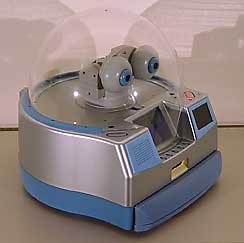 Fujitsu Develops Mobile Phone-Controlled Robot for the Home
Fujitsu Develops Mobile Phone-Controlled Robot for the Home
By Fujitsu
07/10/2002
Fujitsu Laboratories Ltd. today announced that it has developed a new robot for the home, the MARON-1, which can be remotely controlled by mobile phone to operate home electronic appliances or monitor household security.
The ambulatory prototype robot is equipped with a wide range of functions, including telephone, camera, remote control, timer and surveillance equipment. With these features, for example, it is envisioned that MARON-1 could be used for monitoring homes or offices at night or for checking up on persons requiring special care and monitoring.
Fujitsu will be presenting details on the new robot at the Japan Robot Conference, opening October 12, 2002 at Osaka University.
Background
Fujitsu's previous developments in the robotics field include HOAP-1, announced in September 2001. This robot, which was a test platform for bipedal locomotion, is now being distributed by Fujitsu Automation Limited. It is expected that robots will increasingly be used in personal applications and in the future will come to help out around the house as part of people's everyday lives. MARON-1 represents an initial step toward realizing that vision.
About MARON-1
Maron-1 consists of a drive mechanism, a camera that can rotate left, right, up, and down, a programmable remote to control home electronic appliances, and a PHS communication card that, together with specially designed i-appli (*1) software, enables the robot to be operated remotely by mobile phone.With remote operation by mobile phone, the robot can take pictures and relay them to the phone's screen, so that the owner can check conditions at home. The owner can give precise commands for moving the robot forward, backward or turning in a desired direction. In addition, by storing the home's layout in the robot's memory, the owner can give the robot a destination, and it will automatically navigate to that point, avoiding obstacles and maneuvering over door saddles and other surface gradations along the way. Alternatively, a pattern may be established for it to patrol a designated course.
Images sent by the Maron-1 can also be used for specifying a destination. The robot's infrared remote control capability can be used to operate appliances such as air conditioners, televisions and VCRs.
By positioning the robot one or two meters from a spot the owner would like to monitor (for example, the front hall or a window) and turned appropriately, MARON-1 is able to detect anyone or anything entering its field of view. If it does detect an intrusion, it can sound an alarm and call a pre-set number.
The robot can also be scripted to take specific actions at specific times. For example, it can be used as an alarm clock or timer, or it can be programmed to take pictures around the house at pre-set times.
With its built-in PHS capability, the robot can be used as a hands-free telephone. Frequently dialed numbers can be stored in its memory for one-touch dialing. Other commonly performed actions may also be assigned to function buttons.
MARON-1: Main Specifications
| Dimensions: | 32 x 36 x 32 cm |
| Weight: | 5 kg |
| Operable parts: | 2 powered wheels (left, right); 1 rotating arm; 2-way movable camera head (pan, tilt). 5 degrees of freedom |
| Sensors: | 1 Infrared sensor/emitter (for operating electronics by remote); 2 cameras,
1 proximity sensor |
| User interface: | 1 touchpad; 5 menu keys; 2 function keys; 1 4" LCD monitor; 1 microphone; 1 speaker |
| Operating system: | WinCE 3.0 |
| Expansion interfaces: | 1 USB (host); 1 PC card slot; 1 RS-232C port (for maintenance); 1 DC-IN connector |
| Battery type: | NiMH (in main unit) |
| Run time per charge: | 12 hours (*2) |
| Accessory: | AC adapter |
Fujitsu is actively pursuing research and development of new robotic applications and related software, and the company plans to translate these ideas into innovative products.
Glossary
*1. i-appli
Application software which runs on NTT DoCoMo mobile phones.
*2.
Assuming low-power mode and 20 minutes of driving. Run time will depend on the ambient temperature, manner of operation, and other factors.
Read the full press release and specifications
|